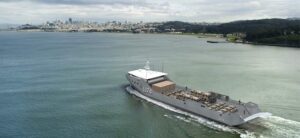
The Marine Corps is considering adding containerized missiles to the Light Amphibious Warship (LAW) to help better deter opponents, Commandant Gen. David Berger said in written testimony to the House Appropriations Defense subcommittee last week. “Some critics of our Force Design 2030 suggest that non-stealthy platforms such as the LAW, LPD-17 class amphibious ship, and the current Group 5 [Unmanned Aircraft Systems] are operationally unsuitable for high-end warfighting,” Berger wrote on April 29. He said this criticism assumes current stealth…

 By
By 











